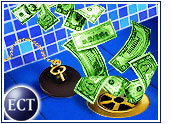
When Amazon.com (Nasdaq: AMZN) announced its second-quarter 2002 results, its outlook seemed promising: Sales of books, CDs and DVDs were up 20 percent compared with the year-ago period. The company’s first-quarter report also was positive, showing a 15 percent increase from the first quarter of 2001.
However, not everything the e-tailer touches turns to gold. Along the way, Amazon has made some missteps, although it seems to be mastering the art of nurturing new ventures despite early stumbles.
Perhaps the company’s biggest misfire in recent months has been its electronics, tools and kitchen (ETK) segment, which fell short of initial expectations and has not yet turned a profit — but even that business unit seems to be moving in a positive direction.
Upward Trend
For example, Amazon founder and CEO Jeff Bezos attributed the company’s improved second-quarter results partially to the performance of the ETK segment, which grew 16 percent between the second quarter of 2001 and the same period in 2002.
Bezos attributed last quarter’s ETK growth to lower prices and an expanded selection — up 40 percent to more than 60,000 items. Reduced shipping charges on orders of more than US$100 — a threshold that was later reduced to $25 — also may have spurred sales, according to analysts.
However, although the ETK business may be less of a drain on the company’s bottom line — losses in the second quarter totaled roughly $18 million — it has yet to live up to Bezos’ great expectations.
Executives at Amazon declined to comment.
Still in Early Stages
Supporting the theory that slow and steady growth could overcome initial stumbles, Morningstar.com analyst David Kathman said he believes Amazon is still in the early stages of developing its ETK business.
“It’s too early to call them a failure,” Kathman told the E-Commerce Times. “They have definitely been improving.”
If any online retailer can make sales of electronics and housewares work alongside sales of books, CDs and DVDs, Kathman added, it is Amazon.”They are better than anybody else at the logistics of selling online and getting it to people,” he noted. “They have learned to execute very well.”
Difficult Market
On the downside, challenges in the ETK business are very different from those in the books, music and video segment, according toAndrew Bartels, vice president of technology and electronic commerce strategies at Giga Information Group.
“With books and music, the stuff in your inventory has a fairly long shelf-life on average,” Bartels told the E-Commerce Times. “A DVD, CD or a book may have demand for two, three, four years … while a CD player may be obsolete in six months.”
Bartels added that because the ETK customer base is smaller, he believes Amazon may have a hard time negotiating the types of discounts that it currently receives on, say, books.
High Hurdles
Shipping charges, too, could eat away at the profits Amazon can garner in the ETK business, because shipping costs for books, music and video are considerably less than those for electronic goods.
But the final hurdle is that customers wish to test and touch ETK products, especially big-ticket items.
“People usually have a strong tendency to see what the TV set looks like or hear how the stereo sounds before they buy it,” Bartels said. “They may want to research online and narrow down their choices, but they will often want to handle the merchandise before they make the buy.”
Partnerships Over Products
Though Kathman said Amazon eventually could turn a profit in its ETK business, he is skeptical that the segment ever will be more than a niche market for the e-tail giant.
But Amazon’s future may not lie in ruling the ETK kingdom. Rather, the company may be striving to ink more partnerships similar to the Target deal announced in August. In that arrangement, Amazon provides products, order fulfillment and guest services for the online arms of Target, Marshall Field’s and Mervyn’s.
Office Depot also joined the Amazon team of partners earlier this month, announcing it would provide its merchandise at an online store that is part of the Amazon site. Office Depot will manage inventory and product fulfillment at the new store, while Amazon will process transactions.
Deals like these “leverage their fulfillment system, which is state of the art; it leverages their customer service and customer base, and it gets them a steady stream of revenue without the risk it incurs from taking inventory,” said Bartels.
Other Fringe Services
In addition to Amazon’s sales of items outside its core product areas, partnerships with individual retailers in its zShops and auction arenarepresent another revenue stream for the company, although it could more fittingly be described as a trickle.
Bartels said Amazon’s auction offering has not fared as well as its zShops, where “affiliate” e-tailers can align with Amazon to reap the benefit of the company’s customer base. However, he noted, maintaining its auction infrastructure likely does not cost Amazon much in terms of resources. “It may be [that] at their low volumes, they are making money,” he said.
Both Bartels and Kathman said it is difficult to track how well services like zShops and auctions are doing.
Regardless of whether its ventures are instantly successful or long-term late bloomers, Amazon seems well positioned not only toremain a giant in its field, but also to extend its reach and correct its missteps without falling behind in the race for e-tail dominance.


























































Social Media
See all Social Media